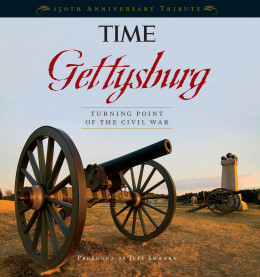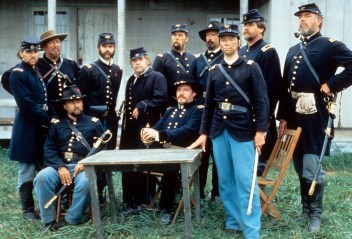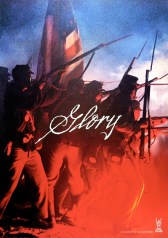
[This story appeared in slightly different form in the Time Home Entertainment book Gettysburg.]
History, the saying goes, is written by the victors. Yet in most of the most popular movies about the Civil War, the Confederacy held the rooting interest.
D.W. Griffith’s The Birth of a Nation, by far the biggest hit of the silent-film period, saw the Union Army as transgressors on a hallowed land, the Reconstruction Era as an act of obscene punishment, blacks as barbarians turned useful fools by Northern politicians, and the Ku Klux Klan as a heroic vigilante force — knights in white bed sheets. Buster Keaton’s The General, surely the funniest and perhaps the most specifically accurate of classic Civil War movies, is also solidly on the Rebel side. Gone With the Wind, which remains the all-time top movie in terms of tickets sold (Star Wars is second), may paint a knowing panorama of the antebellum and postwar South, but it skirts the sad fact that the source of the region’s wealth was its cheap slave labor, a 200-year traffic in souls.
Part of the bias in these films may be attributed to the antique time in which they were made. The Birth of a Nation premiered in 1915, the 50th anniversary of Robert E. Lee’s surrender at Appomattox, when the Civil War still stirred and roiled the memories of many its survivors, as the Vietnam conflict does today. The General came out in 1926; and Gone With the Wind opened in 1939, exactly as distant from today (74 years) as it was from 1865. When those films first played in theaters, racial attitudes had only incrementally evolved from Civil War days; African-Americans were counted as citizens but not always as equals. Further, the Old South, as dewily portrayed in these movies and many others, radiated the romance of some mythical kingdom, where drawling gents sipped mint juleps and kissed the hands of belles in crinoline. This courtly society was seen as more precious because it had vanished. Thus did the lingering fantasy of a cotton Camelot allow history to be written by the losers.
A FEW SHOTS AT THE BATTLE
In this rosy miasma, any serious depiction of the Battle of Gettysburg, which lasted from July 1st to 3rd, 1863 — 150 years ago this week — would carry the rude shock of a face slap into reality. Some of the military strategies utilized on that Pennsylvania field were bold and successful, others rash and nearly suicidal. But in essence it was mutually assured destruction, a three-day skirmish with a terrible price: of the 50,000 casualties from both sides (including the wounded, captured and missing in action), nearly 10,000 soldiers perished on the fields of battle.* What warming lessons could be taken from America’s largest single bloodbath? Only those enunciated in Nov. 1863 by Abraham Lincoln — which is why the Gettysburg Address is cherished in popular culture, and the Battle of Gettysburg all but ignored. Eloquence trumps atrocity.
The 16th President has been the subject of more than 300 movies since the beginning of cinema, from Ralph Ince in the 1911 Battle Hymn of the Republic to this year’s Oscar winner for Best Actor, Daniel Day-Lewis, in Steven Spielberg’s Lincoln. Walter Huston played him in Griffith’s first talking picture, Abraham Lincoln, which the director may have intended as an atonement of sorts for The Birth of a Nation. Lincoln, of course, was Commander in Chief, not a General, and the films that put him at their center rarely stray for long onto the Civil War battlefield.
(SEE: Richard Stengel’s interview with Lincoln director Steven Spielberg)
In 1913, a few one- or two-reel shorts marked Gettysburg’s golden anniversary by dramatizing it in brief. And last year three disparate works of pop culture alluded to that signal conflict. On an episode of Homeland, the double-spy Brody took his family to the site and made a side trip to a tailor’s shop for an explosive suicide vest. In the video for their top-of-the-pops single “Some Nights,” the band fun. donned blue or gray uniforms and mimed Civil War combat to a march tempo (“This is it, boys, this is war. / What are we waiting for?”). And in the historico-horror action film Abraham Lincoln: Vampire Hunter, the fate of the Union rests on the President’s mission to get a train through to Gettysburg while fighting off hundreds of the Confederate undead.
The battle also gets a shout-out this week in the revisionist action film The Lone Ranger, when a rapacious railroad baron (Tom Wilkinson) says, “I was at Gettysburg — 12 thousand cadavers before lunch. You know what I learned? No victory without sacrifice.”
For a century, though, the movies have mostly been mute on the battle itself. One could almost say that Hollywood has dedicated not a single feature film to it.
TED TURNER’S BATTLE
The “almost” is Gettysburg, Ronald F. Maxwell’s four-and-a-half-hour war epic that was made for TV but, at the enthusiastic insistence of its sponsor, Ted Turner, released briefly in theaters. Turner backed the project after many executives at the major studios had rejected it — some more than once. The film’s savior asked only that he appear fleetingly on camera. He plays a Confederate officer who shouts, “Let’s go, men!” and is promptly killed. Noting that his scene needed to be shot only twice, Turner told the director, “Just call me Two-Take Ted.”
Though the source book, Michael Shaara’s The Killer Angels, won the 1975 Pulitzer Prize for fiction, Maxwell infused the story with suitable authenticity. Receiving permission to shoot on part of the battlefield, now a National Military Park, he recruited some 4,000 Civil War reenactors to serve as extras and amateur historians. Perhaps inevitably, this docudrama is stronger on docu than on drama. Some members of the professional cast, led by Tom Berenger as Lt. Gen. James Longstreet and Martin Sheen as Gen. Lee, seem more uncomfortable than the reenactors. The film’s outstanding performance is by Jeff Daniels, as the college professor turned Union officer Joshua Chamberlain, who underlines the band-of-brothers theme by telling his men, “We’re fighting for each other.”
(READ: Richard Schickel’s review of Gettysburg)
The battle scenes necessarily telescope the huge numbers of the warring troops — 170,000, equal to the population of Boston at the time — but adequately approximate the military strategies and, in the climactic and tragic Pickett’s Charge, fitfully display a sad grandeur. A flop in movie theaters, Gettysburg found its true home on DVD and in schoolrooms, where it functions as a useful audio-visual aide to the observation by Civil War Gen. William Tecumseh Sherman that “War is Hell.”
THE POWER OF ‘GLORY’
That is the conclusion reached by virtually all Civil War movies, whether or not they focus on the battlefield, and even if military service is the dream of the characters portrayed. The 1989 Glory describes the training of the 54th Massachusetts Volunteer Corps, the first formal U.S. Army unit entirely composed of black soldiers, under the leadership of Col. Robert Gould Shaw (doe-eyed Matthew Broderick), the scion of wealthy white abolitionists. Written by Kevin Jarre from Shaw’s letters, and directed by Edward Zwick, Glory nicely details the backgrounds of the volunteers: Thomas Searles (Andre Braugher), a free black; John Rawlins (Morgan Freeman), a gravedigger whom Shaw promotes to Sergeant Major; and Trip, an escaped slave (Denzel Washington in a subtle, powerful performance that earned him an Oscar for Best Supporting Actor).
The 54th distinguished itself in the second assault on Fort Wagner, S.C., two weeks and a day after the Gettysburg battle ended. It is hardy worth a SPOILER ALERT to note that Fort Wagner was never taken, and that Shaw and most of his volunteers — who showed their bravery as much in the grace with which they endured the abuse of white Union soldiers as in their chimerical charge across the beach and toward the Fort — died in the attempt.



